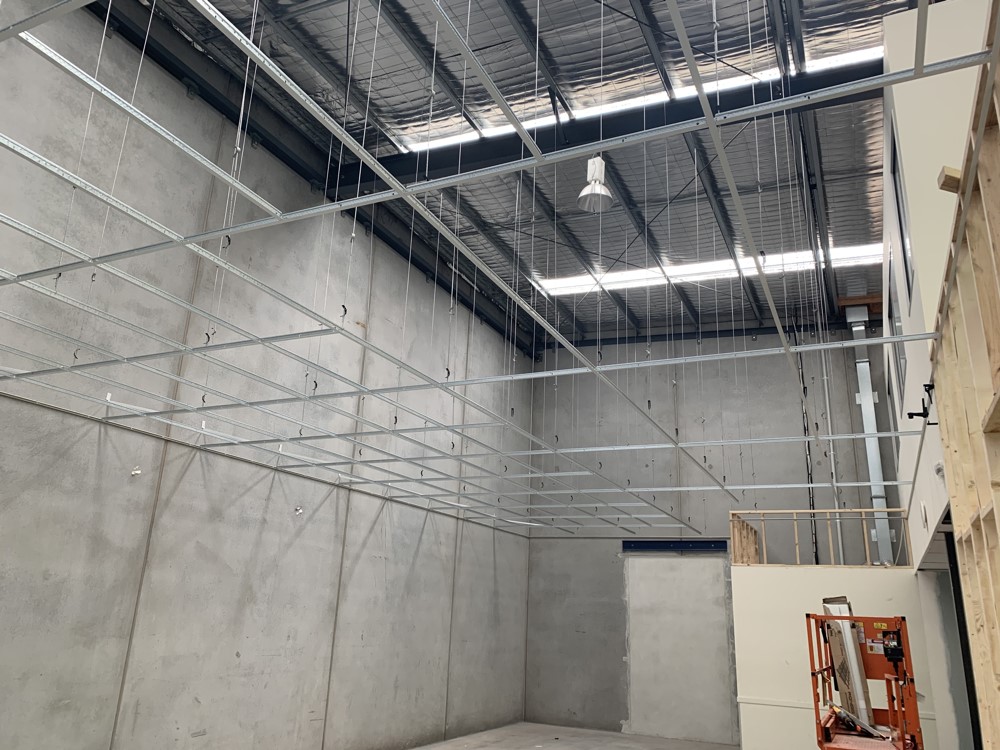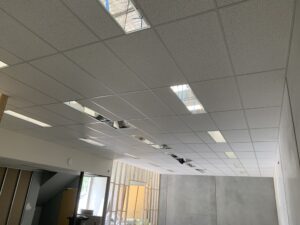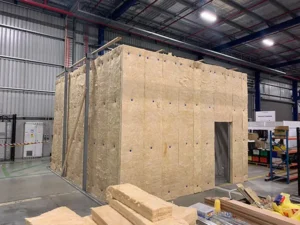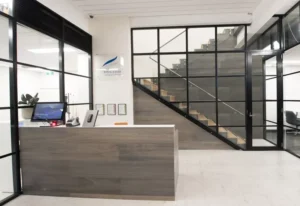Suspended Ceilings in Australia
Suspended ceilings are a type of ceiling system hung from the structural ceiling. They are also called false ceilings, hanging ceilings, t-bar ceilings, or drop-in ceilings. They are usually made from metal or PVC and create varying looks and effects.

Suspended ceilings are economical and thus often used in commercial and office spaces, but that doesn’t mean they aren’t found in hundreds of homes. They can bring in a hefty cost if not managed carefully using experienced services. Before hiring a team make sure to do your own research on costs associated with suspended ceiling installation and the quality of materials used.
A professional should ideally be the one installing a drop ceiling to ensure that there are no issues with the installation. The average cost can vary, but this cost guide can help you better identify suspended ceiling installation costs for your space.
Why Install a False Ceiling?
There are many reasons why you might want to install a false ceiling in your home or office, both for aesthetics and functionality.
Benefits
Easy Installation & Removal
Drop ceilings are easier to install compared to other ceiling structures and can almost as easily be removed without damage to the existing ceiling or structures. Even though it can become a DIY project for home settings, we recommend professionals be hired to do the job for offices so the installation can be done in a swift and efficient manner, with limited chance of damage or mistakes.
Acoustics
A false ceiling is often used as an acoustic ceiling for soundproofing and can help improve the acoustic properties of a room. These soundproofing qualities are a plus if you have family, rowdy roommates, or simply a team of coworkers on the same floor.
You can add the false ceiling to a loud room, like a game or entertainment room, or a room where you would want some peace and quiet, such as a bedroom in home settings, and a meeting or presentation room in office settings.
Insulation
Suspended ceilings can also provide additional insulation, keeping your home cool in summer and warm in winter and saving you the costs of having to crank your air conditioning up or down.
Fire Resistance
A suspended ceiling can be made fire resistant with the right kind of fire-grade material, which protects your home against possible future fire emergencies and damages.
Aesthetics
A false ceiling can be any shape or size, as long as your structural ceiling is high enough. You have total creative freedom over what your ceiling looks like. You also have the free hand in choosing from different types of lighting that can be installed through suspended ceilings. A false ceiling can hide damage to your existing ceiling and also be used to conceal ductwork or other unsightly features like electrical wires and plumbing. While damage to a suspended ceiling might look unflattering, you don’t have to worry about the structural integrity of your home should any accidents occur.
Drawbacks
Despite all the benefits a false ceiling can bring you, there are still some minor drawbacks to consider.
Maintenance
Without constant maintenance, you will find yourself with a damaged ceiling. You can prevent the damage of regular wear and tear by ensuring that your installer uses high-quality materials from the start, but be wary and contact a contractor immediately if you notice signs of deterioration such as sagging due to possible water damage.
Space
In homes and office floors with restricted ceiling height, suspended ceilings could likely reduce space in rooms and make the area appear smaller than it is.
With that in mind, you should balance the pros and cons for yourself to decide if a suspended ceiling is what you want. A suspended ceiling may not work for you if you have a smaller office height, and instead you can consider other small office design ideas to revamp your space.
Types of Suspended Ceilings
There are a few types of ceiling systems to consider for a suspended ceiling installation. They each use a variety of materials and installation methods.
- Suspended drywall ceiling
- Panel Ceiling
- Exposed Grid
- Concealed Grid
Suspended Drywall Ceiling
The most common type of suspended ceiling is the suspended drywall ceiling. A grid of either metal or plastic channels attached to the joists of the house is what supports it.
The drywall is then hung from the grid and finished with paint or wallpaper. This type of ceiling is relatively easy to install and is the most economical option.
Panelled Ceilings
Panel ceilings are another common type of ceiling. Panels attached to the ceiling joists via screws and nails define a panel ceiling. You can make a panel ceiling out of wood, plastic, or metal and you can style them in a variety of ways. Panel ceilings are more expensive than suspended drywall ceilings, but they are also more durable.
Exposed Grid Ceilings
Exposed grid ceilings are a type of ceiling in which you leave the metal framework that supports the tiles or panels exposed. This type of ceiling is usually found in commercial buildings, but it is sometimes seen in homes. Exposed grid ceilings are easy to install and are very durable.
Concealed Grid Ceilings
Concealed ceiling grids are a type of suspended ceiling installed without any visible grid work. You attach the ceiling tiles to the grid system using clips or hangers, and the grid is then hidden behind a trim or moulding. Concealed grid ceilings are more expensive than traditional suspended ceilings, but they offer a clean, modern look.
Ceiling Tiles
Most types of ceilings come with either of the two options: grid or tiles. A drop ceiling can feature both tile and grid or tile only or a grid only. You can make ceiling tiles for drop ceilings for many design reasons and from various materials. The most common tile used is white or off-white made from fibre-board. These tiles can serve as soundproofing tiles or as insulation tiles.
Other ceiling tile choices include aluminium and plastic, which can offer a different type of design element and also bring an ease of painting. You can also find some tiles available in wood or cork.
Suspended Ceiling Cost
Now that you’ve learned the types of drop ceilings and how contractors install them, consider which would be the best fit for you. Four things that can affect the cost of a suspended ceiling include:
- Ceiling Size
- Materials Used
- Labour
- Additional Design Features
Remember that your old ceiling will not be visible and that the drop ceiling will act as a new ceiling, so you should invest in the quality of your installation. A basic ceiling is cheaper than a ceiling with additional design elements added, but you’re paying for a new ceiling that you want to be aesthetically pleasing.
Installation costs for a drop ceiling in Australia can range from $30 to $60 per square metre. This cost is the average in Sydney and Melbourne.
Ceiling Dimensions
The square metre of a ceiling can affect how much it costs to install a drop ceiling in Australia because the size of the room will determine how many panels you will need to cover the area. The number of panels will also affect the price of the installation. This increases the labour hours as well as the quantity of materials to purchase.
Cost of Material
A wider ceiling means you will require more materials. This is where you’ll have to consider the type of materials you can use. If you’re looking for a cost-effective price point and you have a large ceiling, basic materials may be the better choice for your home.
The type of materials used can affect the cost of installing drop ceiling tiles. Fibreglass, plastic, fire-grade wood, and Gyprock/plasterboard are all common materials used in suspended ceilings. Out of these, wood is the most expensive and high quality to use.
You can expect to spend about $50 per square metre for plasterboard installation and a little over $100 per square metre for wood.
Cost of Labour
Labour costs can vary depending on the size of the ceiling and whether or not there are things to navigate around, such as exposed electrical wiring, ductwork or plumbing. You can hire someone to install a drop ceiling for as little as $15 per square metre or as much as $90 per square metre.
You can install some types of drop ceilings as a DIY project, but homeowners should be careful to ensure that they secure everything properly.
Additional Costs
As you prepare to have your false ceiling installed, know that additional costs can occur outside of the typical costs for ceiling tiles and labour. Drop ceilings with embellishments such as cornices, which are linear elements installed like moulding where the ceiling meets the wall can increase the final cost. Moreover, the cost to have your ceiling painted or the cost to install modern or extravagant lighting systems can also bulk up your costs.
Get a Quote
A suspended ceiling can be a great quick fix for damaged ceilings or any other aesthetic, sound, or insulation issues especially in commercial settings. This can depend on the variety of drop ceiling styles available alongside several material choices.
A drop ceiling is best when it’s installed by a professional who can ensure quality installation and use of materials to reduce the need for frequent maintenance. For long-lasting and quality work, consider hiring a fit-out service that can guide you better on office fit out costs and provide you with a quote for the overall cost for installing a suspended ceiling that can give your premises the facelift it needs.





